The Old Fashioned Way: Clotted Cream and Scones – How to make old fashioned British-style Clotted Cream and warm, freshly baked English scones.
I have, and always have been, a voracious reader of English novels, and I’d often come upon references to “a cream tea.” This, I believed, was tea with cream in it until I reached the part where the characters tucked into scones and clotted cream. When I first traveled to England I had clotted cream myself, in a little teashop in Devon. It’s what heaven would taste like should heaven have a taste, I thought. And, as is my usual process, I then wondered how such a thing was made.
To American ears, clotted sounds like something’s gone wrong. To us, clotted refers to a bodily healing process, so it’s hard to make the leap to something tasty. But in England, clotted simply describes the look of the cream as it clings together. Once you bite into a golden scone spread thickly with this unctuous concoction, dotted with fresh sliced strawberries, you won’t care what it’s called because it is simply delicious. Clotted cream is also called Cornish cream and Devonshire cream (a nod to its geographical origins). Each area will claim that their clotted cream tastes different from any other. Devon’s cream’s flavor supposedly arises from the peat fires it is cooked over. I have to assume this is the way it once tasted historically, because in the UK today burning peat is frowned upon. Cornwall’s cream is said to have a coarser texture. Incidentally, Cornish Cream was awarded the EU’s Protected Designation of Origin status in 1998. In the past, clotted cream was also called clowtyd, clouted, clowted, and clawted.
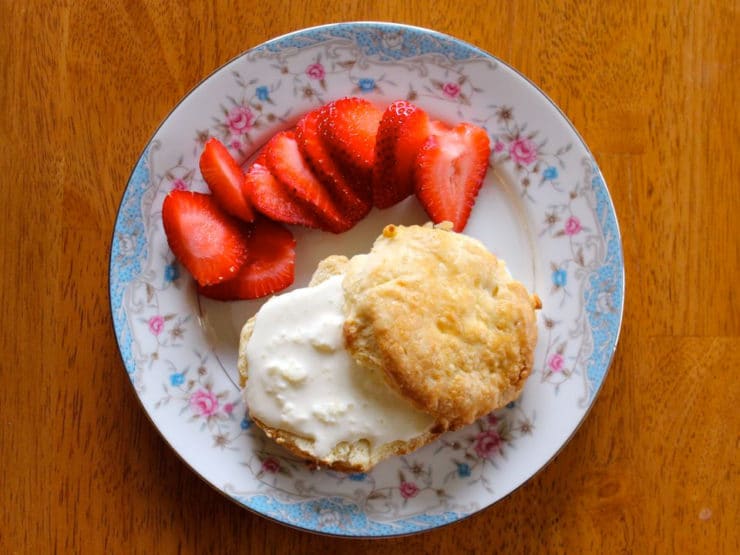
In Devon, the clouting of cream goes back to the Tavistock Abbey estates in the early part of the fourteenth century. Because they had no churns to make butter, they scalded their milk. The resulting clotted cream was stirred and then made into butter. During the sixteenth and seventeenth centuries in Cornwall, clotted cream and butter became the best ways to preserve milk. Later, in British dairies, farmers’ wives would set out a bowl of cream to “settle” for several hours. They would then scald it and let it simmer overnight on their kitchen ranges. As it cooled the next day, the thick, yellow cream was skimmed off and layered into a bowl. Countries other than England also enjoy clotted cream. In Serbia it’s called kajmak, in Turkey it’s kaymak, and in India it’s malai. Clotted cream is often described as having a nutty flavor, which is achieved by cooking the cream without boiling it
Clotted cream is hard to find, if not impossible, in the United States, but it is simple to make. It takes a lot of cream to make a small amount of clotted cream. Hmm, you might say, as you survey the small amount of clotted cream that is yielded, but understand that clotted cream is really the cream of the cream of the crop. A pint of cream makes a little less than half a cup of the good stuff. If you’re cooking for a crowd, plan accordingly and make multiple batches!
Here is a recipe from Cornish Recipes Ancient & Modern by Edith Martin, published by the Women’s Institute in 1929:
Use new milk and strain at once, as soon as milked, into shallow pans. Allow it to stand for 24 hours in winter and 12 hours in summer. Then put the pan on the stove, or better still into a steamer containing water, and let it slowly heat until the cream begins to show a raised ring round the edge. When sufficiently cooked, place in a cool dairy and leave for 12 or 24 hours. Great care must be taken in moving the pans so that the cream is not broken, both in putting on the fire and taking off. When required skim off the cream in layers into a glass dish for the table, taking care to have a good “crust” on the top.
Here’s a simpler recipe, along with a recipe for a traditional English scone. Top a freshly baked scone with clotted cream and berries, and prepare to swoon!
Note from Tori: These are amazing for breakfast with homemade scrambled eggs on the side!
Recommended Products:
We are a participant in the Amazon Services LLC Associates Program, an affiliate advertising program designed to provide a means for us to earn fees by linking to Amazon.com and affiliated sites. As an Amazon Associate I earn from qualifying purchases.
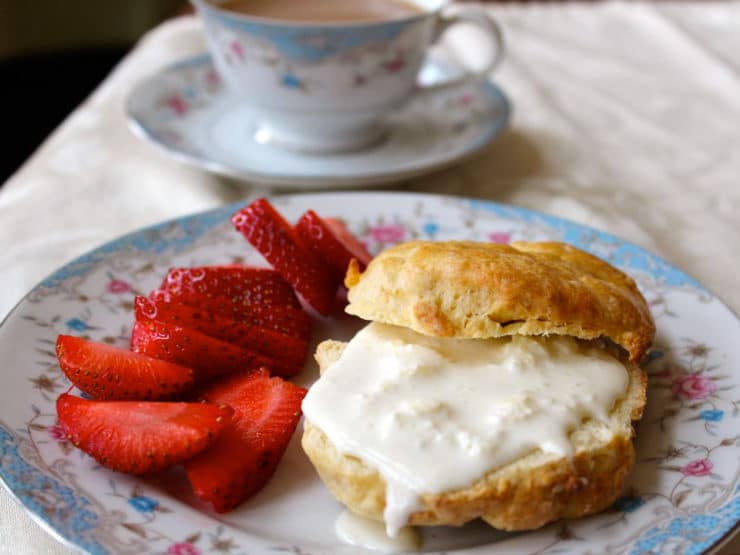
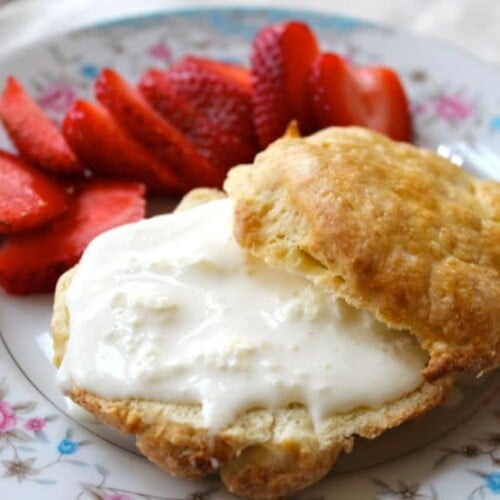
Clotted Cream and English Scones
Ingredients
Clotted Cream
- 4 cups heavy cream (1 quart)
English Scones
- 2 cups all-purpose flour
- 1 tablespoons baking powder
- 1/4 teaspoon salt
- 4 tablespoons unsalted butter, diced
- 1 large egg, beaten
- 5 tablespoons milk
- 1 large egg, beaten (to glaze the tops of the scones)
NOTES
Instructions
To Make Clotted Cream
- In a double boiler over medium heat bring the cream to 175 degrees. If you don’t have a double boiler (and I don’t) place a heatproof bowl over a saucepan of water. Stir a little so that the cream heats evenly. Once you reach 175, bring up the temperature—180 to 200 degrees. Keep that temp for about 45 minutes to an hour. At this point the cream will take on a cracked, yellow skin. Next, remove the bowl or top of your double boiler and settle in a pan of ice water to cool quickly. Cover with plastic wrap and stow in the fridge overnight. Then carefully skim the clotted cream off the top with a shallow spoon and layer it into a bowl. It will keep for about a week in your fridge. Use the rest of the cream as you would regular cream (it will be thinner than heavy cream, but can still be added to beverages).Serve your clotted cream with strawberries or jam on a scone, a slice of pie, or anything that lends itself to cream.

To Make English Scones
- Preheat the oven to 425 and prepare a baking sheet with butter or parchment paper. Sift the flour, baking powder and salt together and then work in the butter. Make a well in the middle and then add the egg and milk. Mix to form a soft dough.Turn the dough out onto a floured surface and then knead quickly until the dough comes together. Roll out the dough to an inch thick, then cut into rounds with a biscuit cutter or water glass. Move to the baking sheet and brush the tops with the beaten egg. Bake for 8 minutes or until golden.

Nutrition

tried this recipe?
Let us know in the comments!
Research Sources:
Thorne, John (1996). Simple Cooking. North Point Press, New York, NY.
McGee, Harold (1984). On Food and Cooking: The Science and Lore of the Kitchen. Scribner, New York, NY.
Trewin, Carol (2005). Gourmet Cornwall. Alison Hodge, Cornwall, UK.
Lane, John. In Praise of Devon: A Guide to its People, Places, and Character. Green Books, Cambridge, UK.
Mendelson, Anne (2008). Milk: The Surprising Story of Milk through the Ages. Knopf, New York, NY
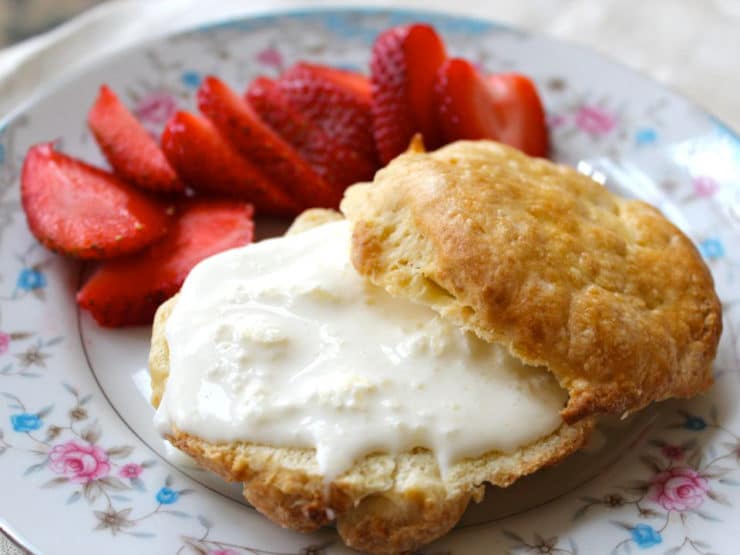

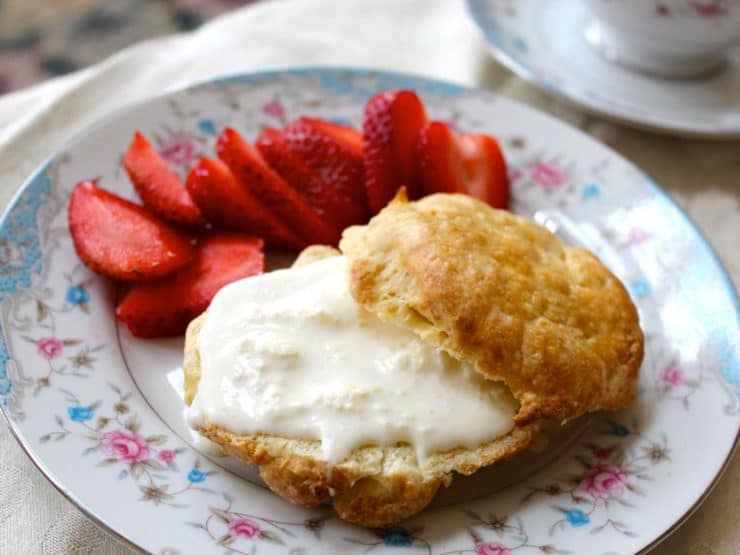

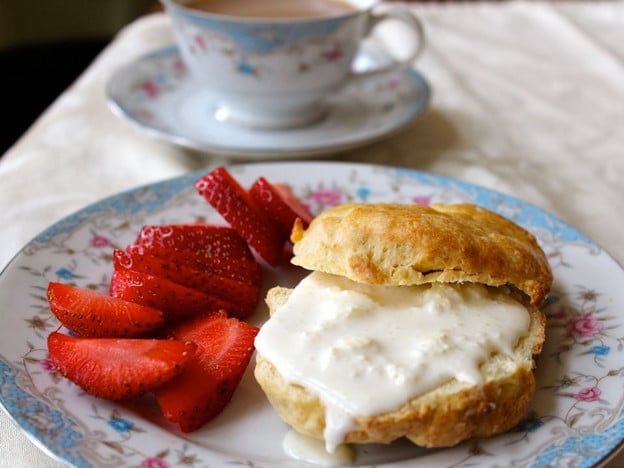


I literally went weak in the knees when I tried this clotted cream the next morning! I love this clotted cream recipe!! I think I futzed with the cream too much while it was cooking, so it didn’t set up amazingly, but I still had a lot of thickened cream. Plenty thick to use on scones. Now that I know where I need to set my stove to cook this, I’ll be able to not touch the cream and let it really cook. Also, after more research, a lot of people said to be super careful not to jiggle the cream when you’re moving it because it’ll impact the setting up. I dropped mine into the ice bath on accident, so much jiggling was had. Can’t wait to make it again!
I’ll update after I make the scones! Can’t wait!
I made the scones and was disappointed. The dough was very dry (I did use half and half instead of milk) and the scones came out very dry and tasting a bit like baking powder. Any suggestions? The clotted cream is amazing!
I followed this recipe to a T and was disappointed.
Let’s start with the cream. I figured that 1 qt of cream would not equal 1 qt of clotted cream, however, I did not expect such little production. What I skimmed off seemed only like 1/10th of what I started with. It tastes good, but unfortunately the majority of the cream left over cannot even be whipped…..
Now for the scones. If you follow the recipe, you will only end up with maybe 3-4 scones at best. In addition, I would highly recommend using super cold butter and milk (much like you would when making a pie crust). Sadly I did not do this and was left with hockey pucks instead of soft, flakey scones. Once your dough is formed, refrigerate for at least 2 hours to firm and then roll out. The scones will barely rise. You will also need to adjust baking time based on the height of your scones.
I will attempt to make the scones again, with the edits above, but the clotted cream is not worth the time and effort. Go with the Americanized version that includes sour cream and a touch of powdered sugar. 😉
Definitely with the cold-butter. Think of English scones as like American biscuits from the South. You can also purchase clotted cream from some stores or Amazon!
The liquid part is basically milk. It is no longer cream. Therefore, it won’t whip. Use the liquid to bake your scones. That way, it is not a waste at all. Clotted cream is not made in large quantities, because it has a short life. Pouring cream into a pan and baking at a low temperature is not a lot of trouble in my opinion, in fact, it is pretty simple. The flavor makes it worth the little effort it takes to make.
Just for fun today, for the first time ever, I made some crumpets for my son and his family. My son, who worked for a while in London a few years ago, asked if I had any clotted cream to go with them! So I had to look up clotted cream online and found your website. It may be a while before I try to make the cream, but your scones and clotted cream and strawberries look delicious! I just wanted you to know how much I have enjoyed your article with all of the wonderful historical information, and the recipes, and the comments! It’s been very interesting reading! Thank you!!
I am excited to try the full recipe. I noticed these biscuits with what looked like cream cheese topping and jam on a show about moving to the country in UK. I finally decided to look online to see what they were and it is cc with strawberries on scones. Thanks for your research and placing the historical nature as well. Looking forward to making and inviting some friends for tea and coffee mother’s day weekend.
I have been making scones since i was 14. My dad was not much of a sweet eater, but he did like scones, so needless to say, i made them quite a bit. I always think of him when i make them… My mum loves scones, and it is such an event when i make them. I have tried many recipes over the years and no matter, each was wonderful. We always have them with lemon curd and jam- strawberry, ginger stem marmalade – whatever, but never tried it with cc! I am going learn how to do this cc so we can have it for our Mother’s Day tea this year. Back to the cream. It is still on the stove, slowly heating…..ok so its been slowly heating for over one hour. Just could not get it hotter than 180. i have cooled it and it is now in the fridge. My friend and I are throwing an afternoon tea tomorrow so hopefully it will turn out. Stay tuned……
Thankyou for the recipe, I’m going to have a go at making it. The picture you have looks very different to what I am used to here in England though; I have never seen it so runny and bitty? It’s normally a thick yellowy creamy product, available in supermarkets and tea shops across the UK. I’ll let you know how it turns out!
I watched two different results (coltted cream) from chefs on YouTube, both done in overn. One disguarded the whey & used the rest being the c.c. The other had no whey when folding off the top layer & he used all that was in the pan as c.c. How good this be???? When I made it I poured very little whey out and stired the rest. Was this the c.c.???? My second question- Put the results in a covered jar & then in the fridge, it harden so I took out what I needed & let it go to room temp. Was this the correct thing to do???? Very confused, Help Please.
In Devon clotted cream was made by placing the freshly milked milk (from cows that gave high cream content milk, like Jerseys) in shallow bowls on the slate counters of the dairy till the cream rises, then heating it very gently for a few hours, and skimming off.
I hope this produces something similar.
You can get clotted cream in many stores now. The Devon Cream company imports a product called English Luxury Clotted Cream.
Help! I am confused about the yellow (is it butter?) “crust” that develops on top of the cooked cream. When separating the clotted cream from the whey (or whatever it is that is left in the pan), should I mix this yellow crust into the clotted cream? Or should I remove the yellow crust and discard it?
This might be a bit late to reply, but you just scoop it up with the rest of the thick cream when you spread it. It’s delicious and considered the real ‘delicacy’ part of clotted cream
You shouldn’t remove the yellow crust-that’s the best part of clotted cream, just put the whole dollop into the bowl and then if you are making bigger amount of clotted cream put the next day’s batch on top of previous day’s batch without mixing or doing anything else. If you are making salty version, just put a bit of salt in between each layer, according to taste and that’s it!
It keeps for many months in a cool place, the longer it ripens, the thicker, drier and stronger it becomes. It can be used straight away if you prefer it soft. By the way this is the way clotted cream is made and used in Serbia.
Important notice: although very tasty, clotted cream is very unhealthy if large amounts of it are eaten at once. Basically, it is as concentrated milk fat as you can get, only butter is more fatty than clotted cream!
As the recipe indicates the yellow skin on top iS the clotted cream that’s what you skim off and use.
I will be going to England in July and hope to get to tast this. To me it sounds wonderful but dont think I want to try making it.
Is OK to prepare the dough ahead and freeze them? Thanks!
Make the scones, bake, cool, put into a plastic container and then freeze. When you need them, take them out of the freezer or take out as many as you need and thaw at room temperature. They will taste as if you had just made them.
I love Clouted Cream (how my grandmother spelled it)! Just remember when making your cream…use a bowl that will not shatter when plunged into the ice water bath. I used to use an enameled metal bowl, but now I have a double boiler.
Margaret is correct, this is a worthy try but bares no comparison at all to the real thing. It is just not possible to make clotted cream in the U.S.
Should be thick and golden with a definite crust and yes, a spoon should stand unaided in a bowl of it.
It can be made. Many dairy farms and organic food stores sell a fresh milk and unpasteurized cream. I was able to find a place near me by computer search.
You will know true clotted cream when a spoon stands up by itself when placed in the cream. Devonshire clotted cream also comes from cows that yield a much higher fat content (% ) in the milk than other cows.
Hey Lauren! Great recipe, going to use it this week, but I was wondering; is the degrees fahrenheit or celcius. Thank you!!
Fahrenheit. Enjoy!
This post and the follow up comments are fascinating. Thank you!
There is no way I can get freshly milked from a cow milk. Can you offer a substitute? Can’t wait to try this if I can find a way to do it and not sacrifice the flavor.
You can simply use regular heavy cream from the market. Enjoy!
Ms. Waller, Ms. Avey,
Thank you so much for clotted cream recipe. Having moved from Scotland to America when I was seven, I had a Grandmother who taught me how to bake a proper scone. But I never did watch her make the clotted cream. On Sunday afternoons, she would set up tea in the “with”drawing room, with fresh baked scones, her jarred jams, and clotted dream. It was heaven! I have to say now, that with your recipe, my clotted cream is awesome now. I did purchase a clip-on thermometer, and have marked the burner dial with a sharpie, as to the exact position, to hold the cream at 190 degrees. Also, have found out that the Costco Heavy Cream, yields more, and with a better flavor. Once again, thank you so much.
Hello!
I LOVE to bake and I especially love European desserts and pastries. I would love to learn how to make scones the right way.
Do you have a scone recipe you don’t mind sharing? If it’s a family secret I understand ?
I would be so grateful.
Thanks!
Fantastic scones…. delicious..yummy..
Yessssssss!!!!! I miss my cream
I made this recipe and the scones turned out great – very authentic traditional scones!